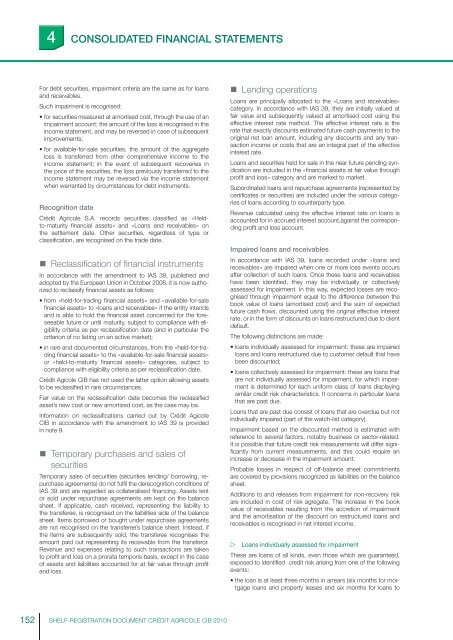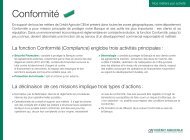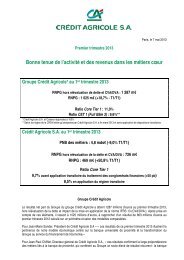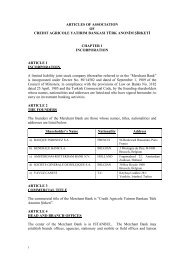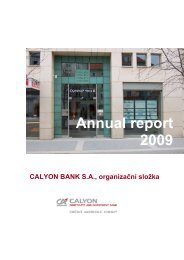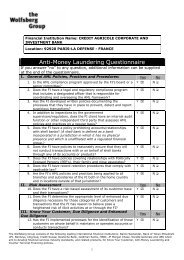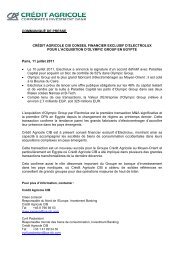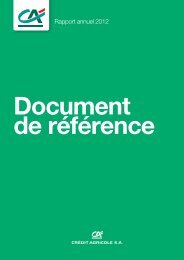ourexpertise - Crédit Agricole CIB
ourexpertise - Crédit Agricole CIB
ourexpertise - Crédit Agricole CIB
Create successful ePaper yourself
Turn your PDF publications into a flip-book with our unique Google optimized e-Paper software.
4CONSOLIDATED FINANCIAL STATEMENTSFor debt securities, impairment criteria are the same as for loansand receivables.Such impairment is recognised:• for securities measured at amortised cost, through the use of animpairment account; the amount of the loss is recognised in theincome statement, and may be reversed in case of subsequentimprovements;• for available-for-sale securities, the amount of the aggregateloss is transferred from other comprehensive income to theincome statement; in the event of subsequent recoveries inthe price of the securities, the loss previously transferred to theincome statement may be reversed via the income statementwhen warranted by circumstances for debt instruments.Recognition date<strong>Crédit</strong> <strong>Agricole</strong> S.A. records securities classifi ed as « Heldto-maturityfi nancial assets » and « Loans and receivables » onthe settlement date. Other securities, regardless of type orclassifi cation, are recognised on the trade date.• Reclassifi cation of fi nancial instrumentsIn accordance with the amendment to IAS 39, published andadopted by the European Union in October 2008, it is now authorizedto reclassify fi nancial assets as follows:• from « held-for-trading fi nancial assets » and « available-for-salefi nancial assets » to « loans and receivables » if the entity intendsand is able to hold the fi nancial asset concerned for the foreseeablefuture or until maturity, subject to compliance with eligibilitycriteria as per reclassifi cation date (and in particular thecriterion of no listing on an active market);• in rare and documented circumstances, from the « held-for-tradingfi nancial assets » to the « available-for-sale fi nancial assets »or « held-to-maturity fi nancial assets » categories, subject tocompliance with eligibility criteria as per reclassifi cation date.<strong>Crédit</strong> Agicole <strong>CIB</strong> has not used the latter option allowing assetsto be reclassifi ed in rare circumstances.Fair value on the reclassifi cation date becomes the reclassifi edasset’s new cost or new amortized cost, as the case may be.Information on reclassifi cations carried out by <strong>Crédit</strong> Agicole<strong>CIB</strong> in accordance with the amendment to IAS 39 is providedin note 9.• Temporary purchases and sales ofsecuritiesTemporary sales of securities (securities lending/ borrowing, repurchaseagreements) do not fulfi l the derecognition conditions ofIAS 39 and are regarded as collateralised fi nancing. Assets lentor sold under repurchase agreements are kept on the balancesheet. If applicable, cash received, representing the liability tothe transferee, is recognised on the liabilities side of the balancesheet. Items borrowed or bought under repurchase agreementsare not recognised on the transferee’s balance sheet. Instead, ifthe items are subsequently sold, the transferee recognises theamount paid out representing its receivable from the transferor.Revenue and expenses relating to such transactions are takento profi t and loss on a prorata temporis basis, except in the caseof assets and liabilities accounted for at fair value through profi tand loss.• Lending operationsLoans are principally allocated to the « Loans and receivables »category. In accordance with IAS 39, they are initially valued atfair value and subsequently valued at amortised cost using theeffective interest rate method. The effective interest rate is therate that exactly discounts estimated future cash payments to theoriginal net loan amount, including any discounts and any transactionincome or costs that are an integral part of the effectiveinterest rate.Loans and securities held for sale in the near future pending syndicationare included in the « fi nancial assets at fair value throughprofi t and loss » category and are marked to market.Subordinated loans and repurchase agreements (represented bycertifi cates or securities) are included under the various categoriesof loans according to counterparty type.Revenue calculated using the effective interest rate on loans isaccounted for in accrued interest account,against the correspondingprofi t and loss account.Impaired loans and receivablesIn accordance with IAS 39, loans recorded under « loans andreceivables » are impaired when one or more loss events occursafter collection of such loans. Once these loans and receivableshave been identifi ed, they may be individually or collectivelyassessed for impairment. In this way, expected losses are recognisedthrough impairment equal to the difference between thebook value of loans (amortised cost) and the sum of expectedfuture cash fl ows, discounted using the original effective interestrate, or in the form of discounts on loans restructured due to clientdefault.The following distinctions are made:• loans individually assessed for impairment: these are impairedloans and loans restructured due to customer default that havebeen discounted;• loans collectively assessed for impairment: these are loans thatare not individually assessed for impairment, for which impairmentis determined for each uniform class of loans displayingsimilar credit risk characteristics. It concerns in particular loansthat are past due.Loans that are past due consist of loans that are overdue but notindividually impaired (part of the watch-list category).Impairment based on the discounted method is estimated withreference to several factors, notably business or sector-related.It is possible that future credit risk measurements will differ significantly from current measurements, and this could require anincrease or decrease in the impairment amount.Probable losses in respect of off-balance sheet commitmentsare covered by provisions recognized as liabilities on the balancesheet.Additions to and releases from impairment for non-recovery riskare included in cost of risk agregate. The increase in the bookvalue of receivables resulting from the accretion of impairmentand the amortisation of the discount on restructured loans andreceivables is recognised in net interest income.Loans individually assessed for impairmentThese are loans of all kinds, even those which are guaranteed,exposed to identifi ed credit risk arising from one of the followingevents:• the loan is at least three months in arrears (six months for mortgageloans and property leases and six months for loans to152SHELF-REGISTRATION DOCUMENT CRÉDIT AGRICOLE <strong>CIB</strong> 2010


